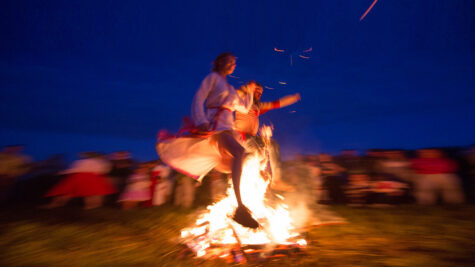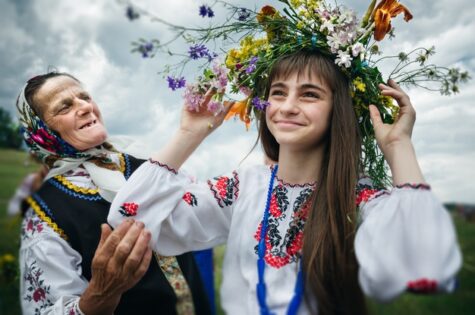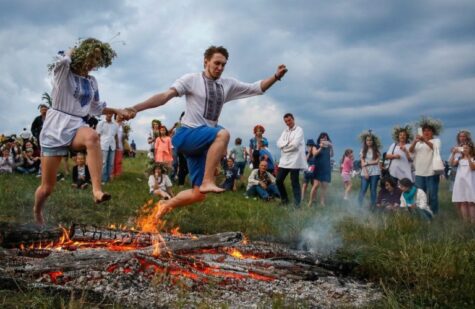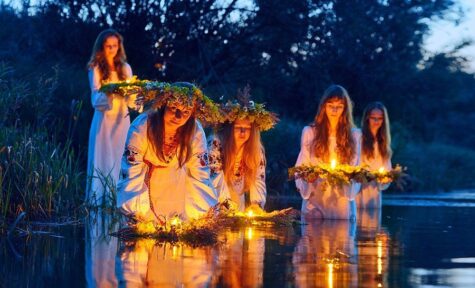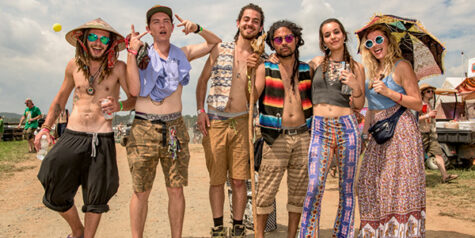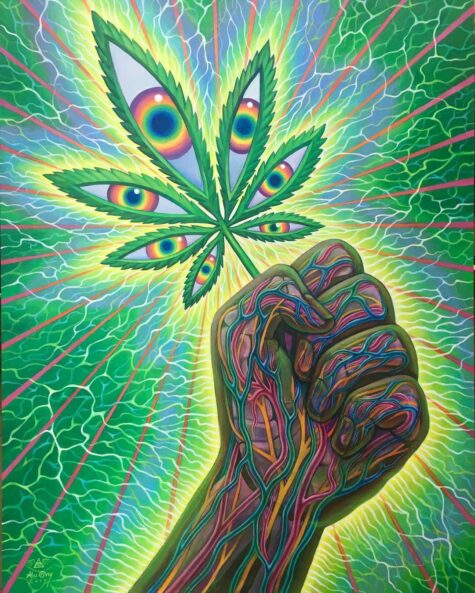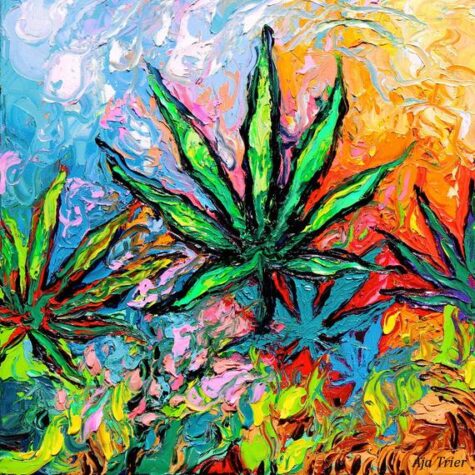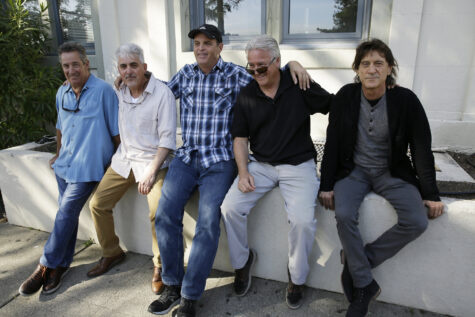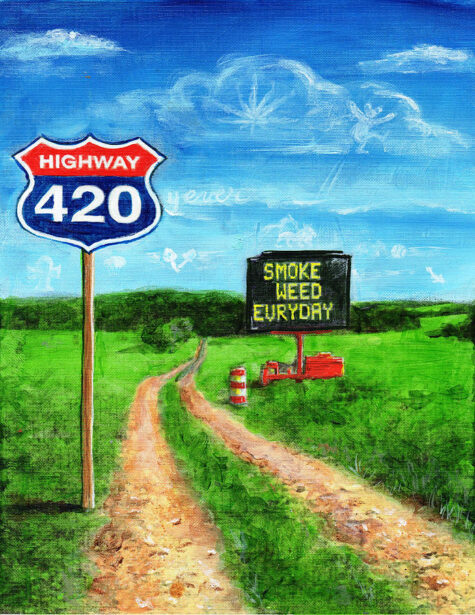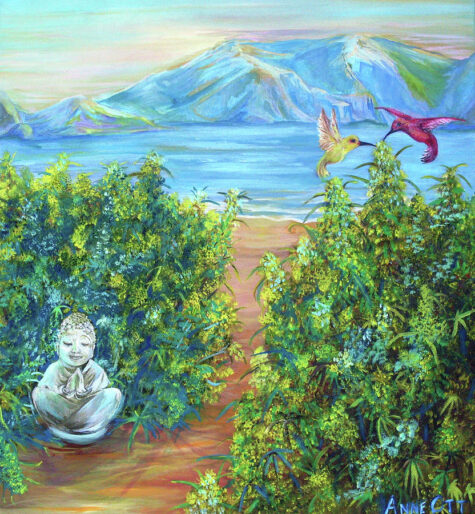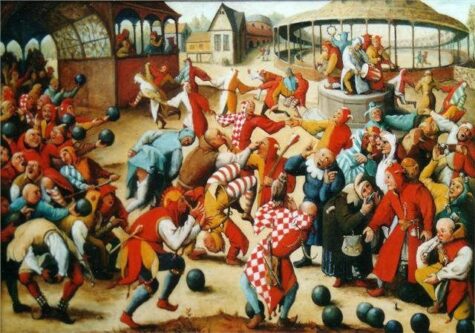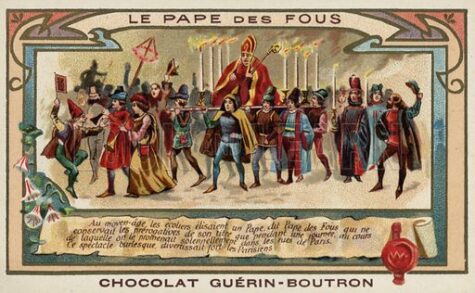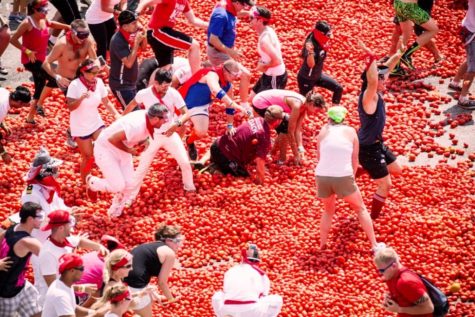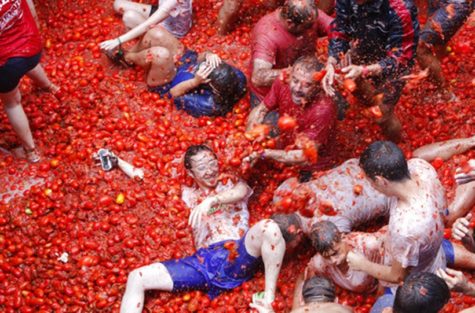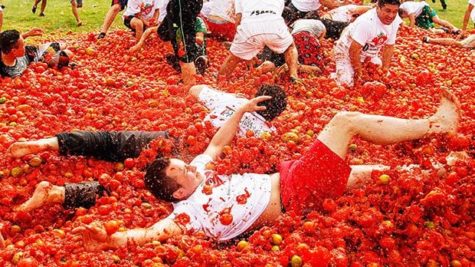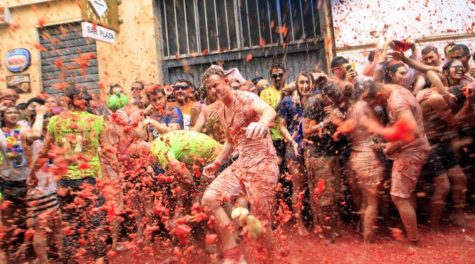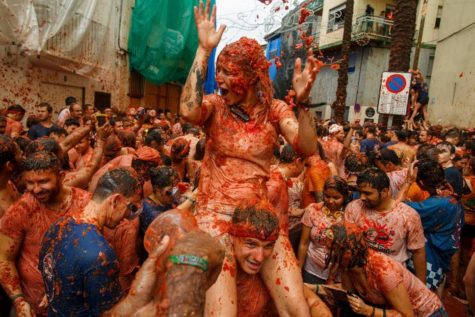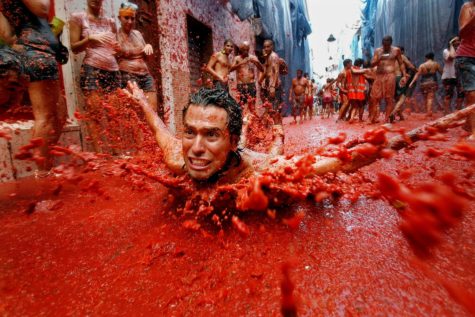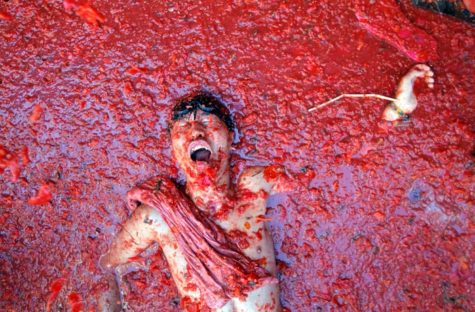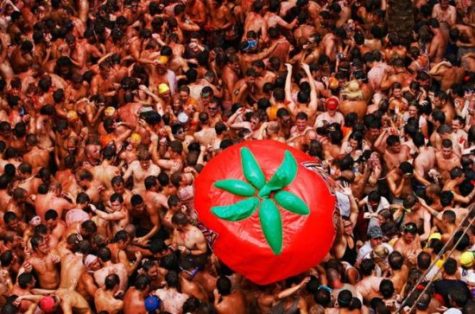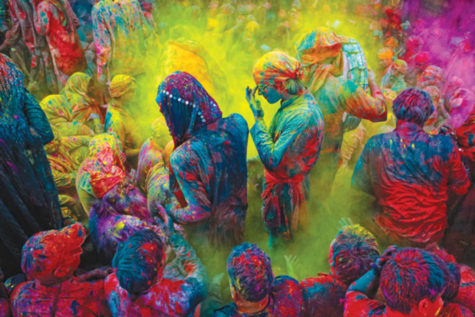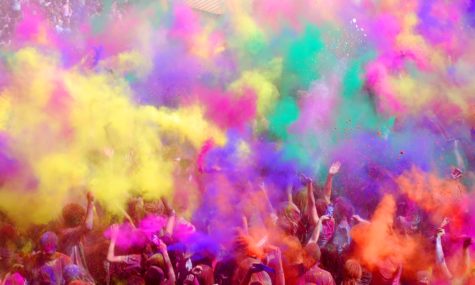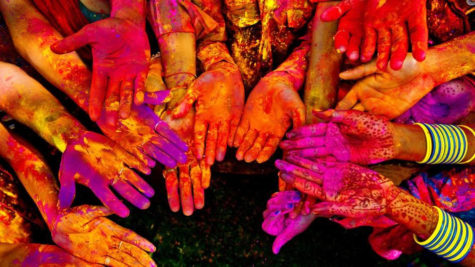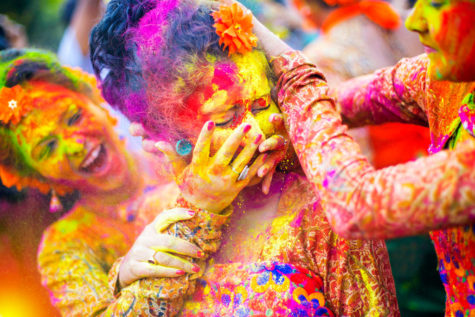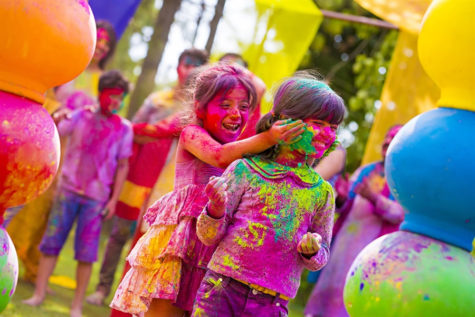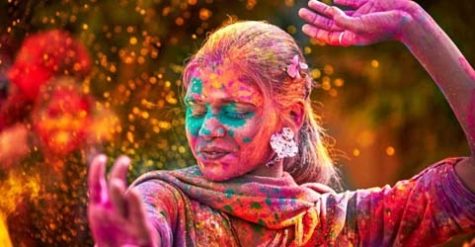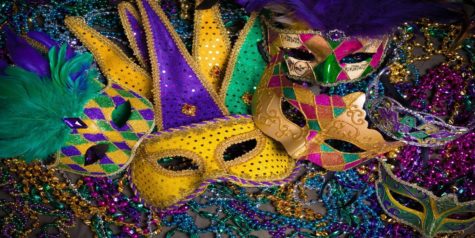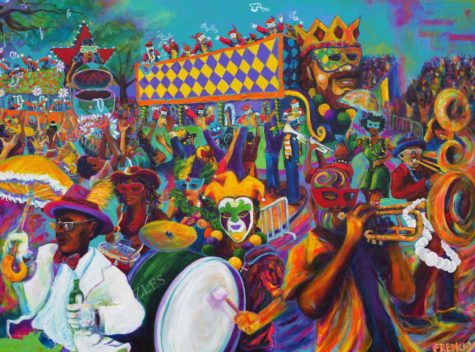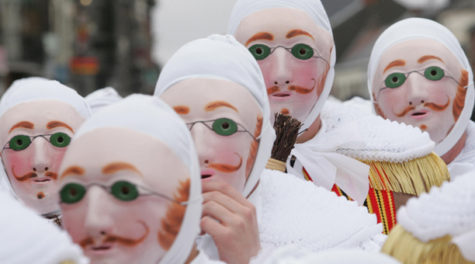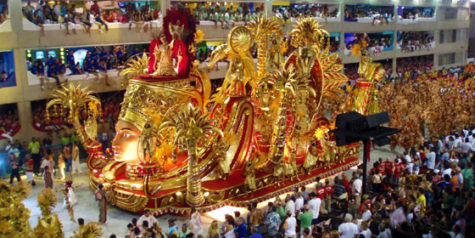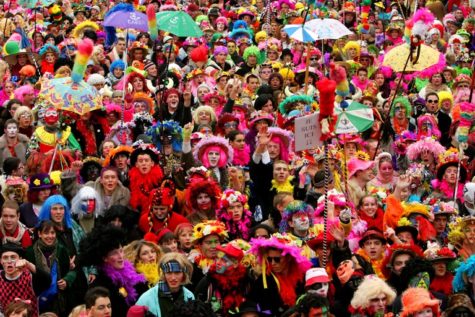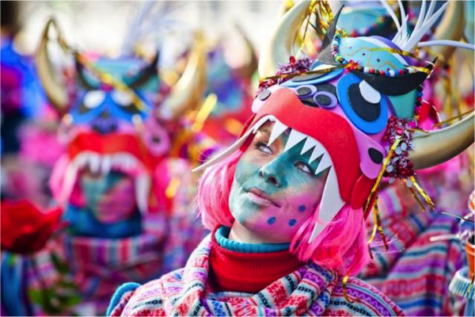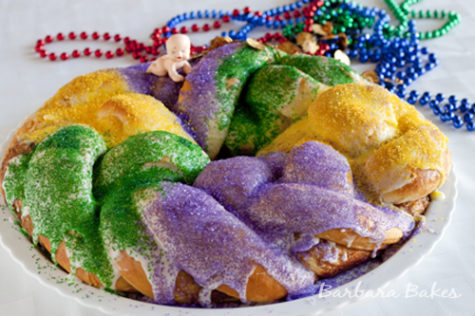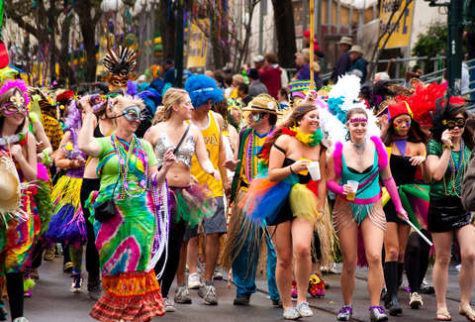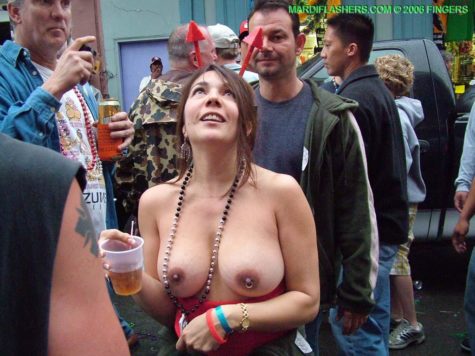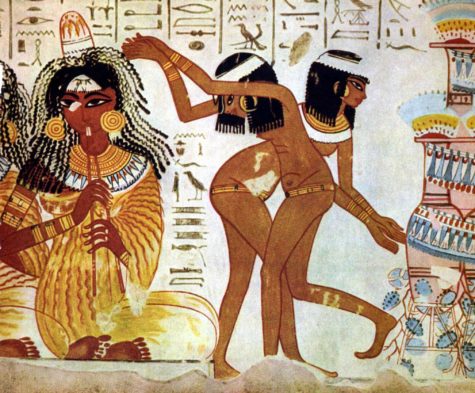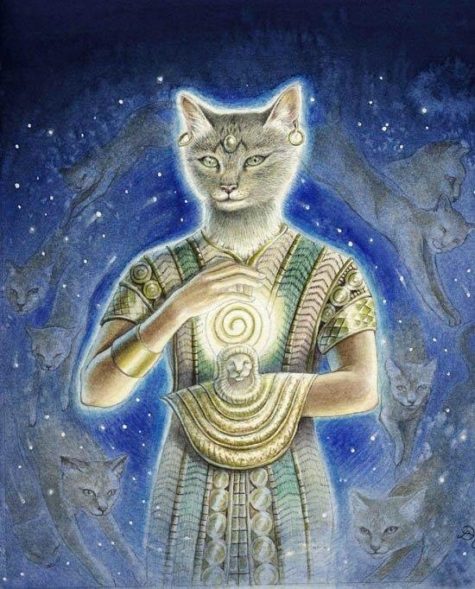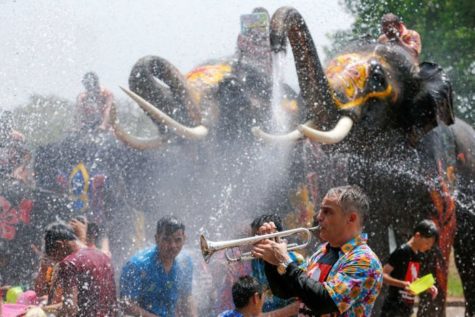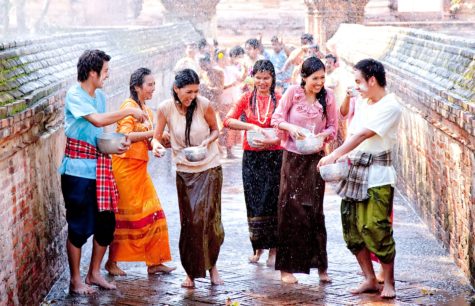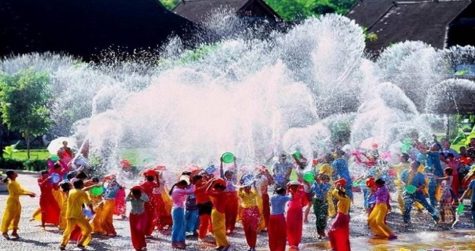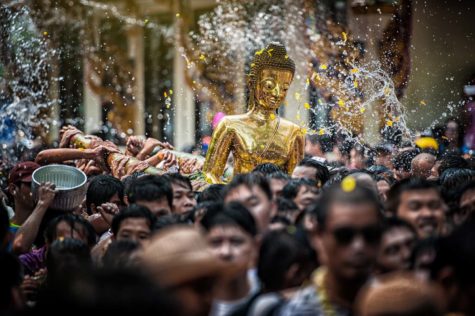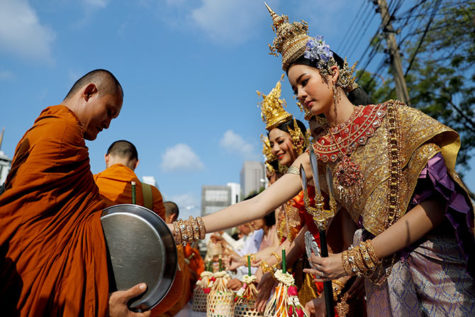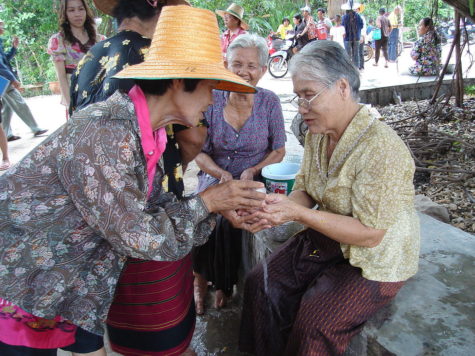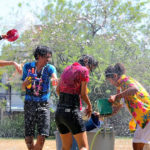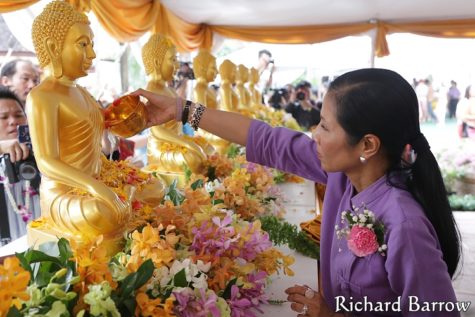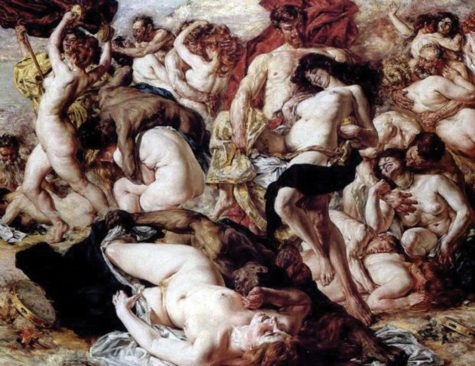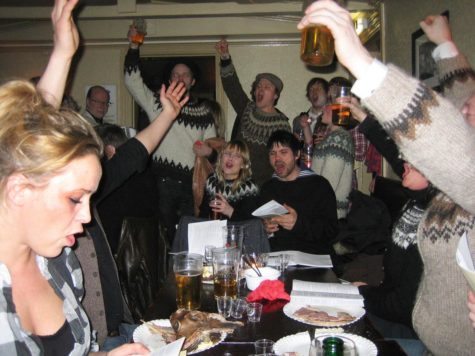Wild Parties
Kupala Night and Ivan Kupala Day is celebrated in Ukraine, Poland, Belarus and Russia from the night of July 6 to the day of July 7 on the Gregorian calendar. This corresponds to June 23 to 24 on the traditional Julian calendar.
The celebration is linked with the summer solstice when nights are the shortest and includes a number of Slavic rituals. This holiday symbolizes the birth of the summer sun – Kupalo.
In the fourth century AD, this day was Christianized and proclaimed the holiday of the birth of John the Baptist. As a result, the pagan feast day “Kupala” was connected with the Christian “Ivan” (Russian for John) which is why the Ukrainian, Belarusian and Russian name of this holiday combines “Ivan” and Kupala which is derived from the Slavic word for bathing.
The two feasts could be connected by reinterpreting John’s baptizing people through full immersion in water. However, the tradition of Kupala predates Christianity. The pagan celebration was adapted and reestablished as one of the native Christian traditions intertwined with local folklore.
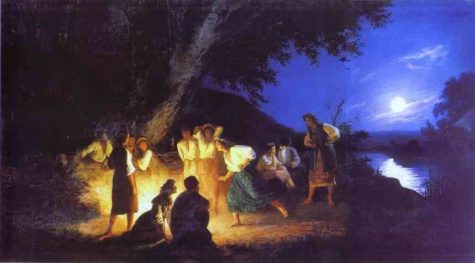
And Then It Was Banned
In the XVIII century, there were a number of documents testifying to the fierce struggle of the Church and secular authorities with the Kupala rite.
For example, in 1719 Hetman of Zaporizhzhia Army, Chairman of the Cossack state of the left bank of Ukraine, Ivan Skoropadskyi issued a decree “On parties, fisticuffs, gatherings on the holiday of Ivan Kupala etc.”, which granted the right to physically punish (tie up and beat with sticks) and excommunicate from the Church all participants of Kupala games.
In 1723, Przemysl Cathedral in Bereziv banned dancing and entertainment near the Kupala fire. In 1769, Catherine II issued a decree banning the holiday. And despite all the prohibitions, the pagan nature of folk rituals was strong. The church did not ban the holiday, but it did try to fill it with Christian content.
It is the pagan essence, mysticism, marriage-erotic motifs of Kupala rite that attracted the attention of many researchers and artists. Thanks to public ritual such art masterpieces as the Opera “Ivana Kupala” by S. Pysarevskyi; folklore work of L. Ukrainka “Kupala in Volyn”; the story of M. Gogol “Night of Ivan Kupala”; the film of Yurii Ilienko “Night on Ivan Kupala”; the Folk Opera of Y. Sankovych “When the fern blooms.” The latter during 40 years was banned and only in 2017 its world premiere took place on the stage of the Lviv Opera.
Kupala Today
At the beginning of the twentieth century Kupala rite gradually began to disappear. Today it exists in the “revived”, or rather “introduced” in Soviet times (during the anti-religious struggle) form of staged ceremony.
Although the magical meaning of rituals was leveled, and the celebration gained artistic value, the main pagan ritual actions have reached us – weaving of wreaths by girls and letting them into the water; honoring Kupala tree with dances; kindling the fire and jumping over the fire; ritual bathing; burning or sinking of trees; the burning of sacks of straw or stuffed dolls; the ceremonial dinner.
It is interesting that the name of the holiday, and the ritual fire, and decorated tree are called “Kupalo”, “Kupailo” or “Kupailytsia”. These are also the main elements of the rituals, which are based on the cult of fire, water and vegetation. Rituals symbolize the union of male (fire) and feminine (water) elements, were carried out with the aim of ensuring productivity, health, procreation.
On the territory of Ukraine for many centuries Kupala customs changed and they were not everywhere equally preserved. The majority were saved in Polissia as one of the more archaic zones of the Slavic world.
The holiday is still enthusiastically celebrated by the younger people of Eastern Europe. The night preceding the holiday (Tvorila night) is considered the night for “good humor” mischiefs (which sometimes would raise the concern of law enforcement agencies).
On Ivan Kupala day itself, children engage in water fights and perform pranks, mostly involving pouring water over people. Many of the rites related to this holiday are connected with the role of water in fertility and ritual purification.
According to ancient traditions, Ivan Kupala is the festival of the sun, and the most important role in mystical rites belongs to the power of fire. Our ancestors believed that the fire is the sun-embryo in the womb. Therefore, in the Kupala night taken to jump over the fire.
On Kupala day, young people jump over the flames of bonfires in a ritual test of bravery and faith. First, the oldest of the young men jumped over the fire.
For the highest jumpers it predicted a good harvest and prosperity for his family. Then pairs would jump, traditionally it would be a boy and a girl, but I assume that in some areas it’s permissible for pairs of any kind to take the jump together. If the couple is successful in their jump over the fire – they will certainly marry. The failure of a couple in love to complete the jump, while holding hands, is a sign of their destined separation. And anyone entering the flames during their jump can expect trouble
On the evening of July 6, unmarried girls take wreaths they have woven and throw them into the water. Unmarried men then try to grab the one belonging to the girl they are interested in. If you snag a wreath, the girl who made it will be expected to kiss you and the two of you will be paired up for the evening.
Girls may also float wreaths of flowers (often lit with candles) on rivers, in an attempt to gain foresight into their romantic relationships based from the flow patterns of the flowers on the river.
When the fun subsides, many people light candles from the hearth on pre-prepared wreath baskets and go to the river to put them on the water and thus honor their ancestors.
There is an ancient Kupala belief that the eve of Ivan Kupala is the only time of the year when ferns bloom. Prosperity, luck, discernment, and power befall whom ever finds a fern flower. Therefore, on that night, village folk roam through the forests in search of magical herbs, and especially, the elusive fern flower.
Traditionally, unmarried women, signified by the garlands in their hair, are the first to enter the forest. They are followed by young men. Therefore, the quest to find herbs and the fern flower may lead to the blooming of relationships between pairs within the forest.
It is to be noted, however, that ferns are not angiosperms (flowering plants), and instead reproduce by spores; they cannot flower.
In Gogol’s story The Eve of Ivan Kupala a young man finds the fantastical fern-flower, but is cursed by it. Gogol’s tale may have been the stimulus for Modest Mussorgsky to compose his tone poem Night on Bald Mountain, adapted by Yuri Ilyenko into a film of the same name.
Sources:
It was Christmas week in Oakland, 1990. Steven Bloom was wandering through The Lot – that timeless gathering of hippies that springs up in the parking lot before every Grateful Dead concert – when a Deadhead handed him a yellow flyer.
“We are going to meet at 4:20 on 4/20 for 420-ing in Marin County at the Bolinas Ridge sunset spot on Mt. Tamalpais,” reads the message. Bloom, then a reporter for High Times magazine and now the publisher of CelebStoner.com and co-author of Pot Culture, had never heard of “420-ing” before.
Since then, April 20 has become an international counterculture holiday, where people gather to celebrate and consume cannabis. Many such events have a political nature to them, advocating the liberalization / legalization of cannabis.
- Vivian McPeak, a founder of Seattle’s Hempfest states that 4/20 is “half celebration and half call to action”.
- Paul Birch calls it a global movement and suggests that one cannot stop events like these.
On this day many marijuana users protest in civil disobedience by gathering in public to smoke at 4:20 pm.
As marijuana continues to be decriminalized and legalized around the world, Steve DeAngelo, cannabis activist and founder of California’s Harborside Health Center, notes that “even if our activist work were complete, 420 morphs from a statement of conscience to a celebration of acceptance, a celebration of victory, a celebration of our amazing connection with this plant” and that he thinks that “it will always be worthy of celebration”.
The code often creeps into popular culture and mainstream settings. Nearly all of the clocks in the pawn shop scene in “Pulp Fiction,” for instance, are set to 4:20.
About 420
Pot smokers and cannabis lovers know that 4:20 is the time to smoke pot. They also know that 4/20 is international pot-smoking day. But not many people know why or how the number 420 became linked to pot smoking.
There are a few old tales which describe how this national holiday, and that special time of the day, became so iconic. Here’s everything we know about how 4/20 became more than a mid-April day.
You know who does know a thing or two about this? Larry “Ratso” Sloman, author of Reefer Madness: A History of Marijuana. The most accepted root of the high holiday starts with some high school kids in San Rafael, California, back in 1971.
Calling themselves the Waldos, because their typical hang-out spot “was a wall outside the school”, the five students (Steve Capper, Dave Reddix, Jeffrey Noel, Larry Schwartz, and Mark Gravich) designated the Louis Pasteur statue on the grounds of San Rafael High School as their meeting place, and 4:20 pm as their meeting time.
The phrase started as “420 Louis,” meaning “at 4:20 meet by the Louis Pasteur statue outside the high school” and get high. Soon it was shortened to 420, and became a catchall phrase for marijuanna consumption.
It turns out one of these kids, had an older brother, Patrick, who was friends with Grateful Dead’s bassist, Phil Lesh. Patrick also managed a couple of Grateful Dead sidebands, Too Loose To Truck and the Sea Stones; they featured not only Lesh but rock legend David Crosby and acclaimed guitarist Terry Haggerty. Patrick tells the Huffington Post that he smoked with Lesh on numerous occasions. He couldn’t recall if he used the term 420 around him, but guessed that he must have.
The kids started getting high with the Grateful Dead at their rehearsal studio in San Rafael. “The Dead,” recalls Waldo Dave Reddix, “had this rehearsal hall on Front Street, San Rafael, California, and they used to practice there. So we used to go hang out and listen to them play music and get high while they’re practicing for gigs.”
The Waldos also had open access to Dead parties and rehearsals partly because Mark Waldo’s father took care of real estate for the Dead. “We’d go with [Mark’s] dad, who was a hip dad from the ‘60s,” says Steve. “There was a place called Winterland and we’d always be backstage running around or onstage and, of course, we’re using those phrases. When somebody passes a joint or something, ‘Hey, 420.’
“So it started spreading through that community. But I think it’s possible my brother Patrick might have spread it through Phil Lesh. And me, too, because I was hanging out with Lesh and his band [as a roadie] when they were doing a summer tour my brother was managing.”
“I started incorporating it into everything we were doing,” High Times editor Steve Hager told the Huffington Post. “I started doing all these big events – the World Hemp Expo Extravaganza and the Cannabis Cup – and we built everything around 420. The publicity that High Times gave it is what made it an international thing. Until then, it was relatively confined to the Grateful Dead subculture. But we blew it out into an international phenomenon.”
Sometime in the early ‘90s, High Times wisely purchased the web domain 420.com.
Origin Story:
One day in the Fall of 1971 – harvest time – the Waldos got word of a Coast Guard service member who could no longer tend his plot of marijuana plants near the Point Reyes Peninsula Coast Guard station. A treasure map in hand, the Waldos decided to pluck some of this free bud.
The Waldos were all athletes and agreed to meet at the statue of Louis Pasteur outside the school at 4:20, after practice, to begin the hunt.
“We would remind each other in the hallways we were supposed to meet up at 4:20. It originally started out 4:20-Louis and we eventually dropped the Louis,” Waldo Steve tells the Huffington Post.
The first forays out were unsuccessful, but the group kept looking for the hidden crop. “We’d meet at 4:20 and get in my old ‘66 Chevy Impala and, of course, we’d smoke instantly and smoke all the way out to Pt. Reyes and smoke the entire time we were out there. We did it week after week,” says Steve. “We never actually found the patch.”
But they did find a useful codeword. “I could say to one of my friends, I’d go, 420, and it was telepathic. He would know if I was saying, ‘Hey, do you wanna go smoke some?’ Or, ‘Do you have any?’ Or, ‘Are you stoned right now?’ It was kind of telepathic just from the way you said it,” Steve says. “Our teachers didn’t know what we were talking about. Our parents didn’t know what we were talking about.”
The Waldos never envisioned that pot smokers the world over would celebrate each April 20th as a result of their foray into the Point Reyes forest. The day has managed to become something of a national holiday in the face of official condemnation.
Push Back
Officials at the University of Colorado at Boulder and University of California, Santa Cruz, pushed back. “As another April 20 approaches, we are faced with concerns from students, parents, alumni, Regents, and community members about a repeat of last year’s 4/20 ‘event,’” wrote Boulder’s chancellor in a letter to students.
“On April 20, 2009, we hope that you will choose not to participate in unlawful activity that debases the reputation of your University and degree, and will encourage your fellow Buffs to act with pride and remember who they really are.”
But the Cheshire cat is out of the bag. Students and locals showed up at round four, lit up at 4:20 and were gone shortly thereafter. No bands, no speakers, no chants. Just a bunch of people getting together and getting stoned.
Alternative Theories
Depending on who you ask, or their state of inebriation, there are as many varieties of answers as strains of medical bud in California. It’s the number of active chemicals in marijuana. It’s teatime in Holland. It has something to do with Hitler’s birthday. It’s those numbers in that Bob Dylan song multiplied.
The origin of the term 420, celebrated around the world by pot smokers every April 20, has long been obscured by the clouded memories of the folks who made it a phenomenon.
- Some People Think Bob Dylan Has to Do With It
This one’s pretty simple. Bob Dylan’s got a song called “Rainy Day Women #12 & 35.” At some point, someone, presumably pretty stoned, was listening to ol’ Bob and realized that if you multiply 12 by 35, you get—you guessed it, 420.
Oh how nice this would be, to trace the high holiday back to one of the best artists to listen to while engaging in the devil’s lettuce. But alas, even though the song was recorded in 1966, well before the Waldos did their thing, it’s highly unlikely this is our one true source.
- There’s a Theory About the Actual Plant, Too
This one’s a shut and closed case, too. Although it has been stated that there are “more than 400 chemical compounds” in a cannabis plant, no one ever clearly stated that that number is 420.
- It’s Got Nothing to Do With Lawmen
This story was reported in a flyer: “420 started somewhere in San Rafael, California in the late ‘70s. It started as the police code for Marijuana Smoking in Progress. After local heads heard of the police call, they started using the expression 420 when referring to herb – Let’s Go 420, dude!”
That story referring to what police would say over the radio should they see you buying a baggie, is incorrect. Unfortunately that radio code is for homicide.
- The One About Congress?
Well, it’s not that the two aren’t related. In 2003, when the California legislature codified the medical marijuana law voters had approved, the bill was named SB420.
“We think it was a staffer working for [lead Assembly sponsor Mark] Leno, but no one has ever fessed up,” says Steph Sherer, head of Americans for Safe Access, which lobbied on behalf of the bill. California legislative staffers spoken to for this story say that the 420 designation remains a mystery, but that both Leno and the lead Senate sponsor, John Vasconcellos, are hip enough that they must have known what it meant.
- More Crazy Ideas
The remaining theories around 420 are so wild we might as well not even go into detail. Some think it’s named after the day Bob Marley died, but he died on May 11.
Some think it has something to do with Adolf Hitler’s birthday, but why the hell would that mean anything? (Even if it is his birthday.)
Lastly, some stoned-off-their-ass person once said April 20 is the best day to plant marijuana, but that very clearly depends on where you’re planting it.
What Happened To The Waldos?
The Waldos say that within a few years the term had spread throughout San Rafael and was cropping up elsewhere in the state. By the early ‘90s, it had penetrated deep enough that Dave and Steve started hearing people use it in unexpected places – Ohio, Florida, Canada – and spotted it painted on signs and etched into park benches.
In 1997, the Waldos decided to set the record straight and got in touch with High Times. “We never made a dime on the thing,” says Dave, half boasting, half lamenting.
He does take pride in his role, though. “I still have a lot of friends who tell their friends that they know one of the guys that started the 420 thing. So it’s kind of like a cult celebrity thing. Two years ago I went to the Cannabis Cup in Amsterdam. High Times magazine flew me out,” says Dave.
Dave is now a credit analyst and works for Steve, who owns a specialty lending institution and lost money to the con artist Bernie Madoff. He spends more time today, he says, composing angry letters to the SEC than he does getting high.
The other three Waldos have also been successful, Steve says. One is head of marketing for a Napa Valley winery. Another is in printing and graphics. A third works for a roofing and gutter company. “He’s like, head of their gutter division,” says Steve, who keeps in close touch with them all.
“I’ve got to run a business. I’ve got to stay sharp,” says Steve, explaining why he rarely smokes pot anymore. “Seems like everybody I know who smokes daily, or many times in a week, it seems like there’s always something going wrong with their life, professionally, or in their relationships, or financially or something. It’s a lot of fun, but it seems like if someone does it too much, there’s some karmic cost to it.”
“I never endorsed the use of marijuana. But hey, it worked for me,” says Waldo Dave. “I’m sure on my headstone it’ll say: ‘One of the 420 guys.’”
What Does “420-Friendly” Mean?
Whether you’re on a dating profile or looking for an apartment to rent on Craigslist, you’ll probably run into the phrase “420-friendly.”
Simply put, if someone is 420-friendly it means they are sympathetic to the cannabis cause and won’t make a big deal if you regularly consume cannabis. They may also consume marijuana.
Stolen Signs
Signs bearing the number 420 have been frequently stolen. In Colorado, the Colorado Department of Transportation replaced the Mile Marker 420 sign on I-70 east of Denver with one reading 419.99 in an attempt to stop the thievery; however, the folklore of the 419.99 sign has caused it to be stolen, too, as well as becoming a tourist destination. As of August 2018, the sign was missing, presumed stolen.
The Colorado DOT usually will not replace signs that are repeatedly taken, but began the practice of replacing further down the road after “69” mile marker signs were frequently stolen – these were replaced with “68.5 mile” ones.
The Idaho Department of Transportation replaced the mile marker 420 sign on U.S. Highway 95, just south of Coeur d’Alene, with mile marker 419.9. The Washington State Department of Transportation implemented similar measures, but only replaced one of the two 420 signs in the state, with the remaining one being subsequently stolen.
According to The Washington Post, there are eleven 420 mile markers in the US, after three replacements and one stolen and not replaced. In Goodhue County, Minnesota, officials have changed “420 St” street signs to “42x St”. The mile marker 420 sign on U.S. Route 89, the only 420 marker in the state of Utah, is also frequently stolen.
Angel Number 420
Has number 420 become a norm in your life? Are you seeing it everywhere, all time? It may mean that the angels are trying to talk to you. If a certain number appears more than once, it may be a message from your guardian angels.
Angel number 420 is reminding you of your spiritual awakening. It is time to start your spiritual journey and be grateful for all the things that you have. Your angels will be with you even in the most difficult situation. When they send you number 420, it means that you can feel safe and protected. Your guardian angels are watching you and they are working in your favor. There is nothing that you should be worried about.
Most important is to have faith in your guardian angels because they will bring great changes in your life. Also, you have to be supportive toward other people. You have to know your soul mission and to be generous and helpful toward others. Very soon you will be rewarded for all good things that you have done in your life.
To sum up, when you see angel number 420, you should not just ignore it, but you should try to understand its meaning. There is no doubt that your angels are preparing you something good, wo you can certainly expect a lot of luck and success in the future.
Sources:
Feast of Fools was a celebration marked by wanton mischief and merrymaking. It took place in many parts of Europe, and particularly in France, every year during the later middle ages on or about the Feast of the Circumcision (1 Jan.). This feast day, as described by the French theologians who condemned it in 1445, sounds like a ton of fun.
This New Year’s Day celebration, they wrote, caught up high-ranking church officials in a bacchanal unworthy of their exalted positions.
“Priests and clerks may be seen wearing masks and monstrous visages at the hours of office,” the theologians recounted, presumably with a sniff of horror. “They dance in the choir dressed as women, panders or minstrels. They sing wanton songs. They eat black puddings… while the celebrant is saying mass. They play at dice… They run and leap through the church, without a blush at their own shame.”
The Feast of Fools was celebrated by the clergy in Europe during the Middle Ages, initially in Northern France, but later more widely. During the Feast, participants would elect either a false Bishop, false Archbishop or false Pope. Ecclesiastical ritual would also be parodied and higher and lower level clergy would change places.
It was known by many names:
- Festum
- Fatuorum
- Festum stultorum
- Festum hypodiaconorum
Officially banned in the 15th century, the Feast of Fools had its origins 300 years before, in the 1100s, and continued as a tradition well into the 16th century. It was memorialized in church documents condemning its excesses and in paintings depicting streets full of merry chaos. It appears in Victor Hugo’s famous 19th century novel, The Hunchback of Notre Dame, when Quasimodo is swept up in the festivities and crowned King of Fools.
This rowdy revelry may never has been quite as raucous as was rumored. It started out as a much tamer liturgical celebration, which accrued an outsized reputation for subversiveness. At its heart, though, the Feast of Fools always turned power on its head—a reversal that naturally made church leaders very nervous.
But outside the church doors, concurrent celebrations were much more irreverent. In these medieval centuries, Harris writes, it became popular for students to parade through the streets with their faces blackened with mud (or even animal dung) to conceal their identities while they parodied clergy, doctors, civil officials, and rulers. These parades certainly featured cross-dressing, drinking, singing, and all manner of other mischief and behavior that usually wouldn’t be tolerated.
Wintertime celebrations like these, where the less powerful parts of society had the chance to break loose for a day, trace their roots to Roman and other European pagan festivals of role-reversal. For a modern day take on this holiday, visit this Feast Of Fools post.
It is difficult to distinguish it from certain other similar celebrations, such as the Feast of Asses, and the Feast of the Boy Bishop. It seems to have grown out of a special “festival of the subdeacons”, which John Beleth, a liturgical writer of the twelfth century and an Englishman by birth, assigns to the day of the Circumcision.
He was among the earliest to draw attention to the fact that, as the deacons had a special celebration on St. Stephen’s day (26 Dec.), the priests on St. John the Evangelist’s day (27. Dec.), and again the choristers and mass-servers on that of Holy Innocents (28 Dec.), so the subdeacons were accustomed to hold their feast about the same time of year, but more particularly on the festival of the Circumcision.
This feast of the subdeacons afterwards developed into the feast of the lower clergy (esclaffardi), and was later taken up by certain brotherhoods or guilds of “fools” with a definite organization of their own. There can be little doubt — and medieval censors themselves freely recognized the fact — that the license and buffoonery which marked this occasion had their origin in pagan customs of very ancient date.
John Beleth, when he discusses these matters, entitles his chapter “De quadam libertate Decembrica“, and goes on to explain: “now the license which is then permitted is called Decembrian, because it was customary of old among the pagans that during this month slaves and serving-maids should have a sort of liberty given them, and should be put upon an equality with their masters, in celebrating a common festivity.” (P.L. CCII, 123).
The Feast of Fools and the almost blasphemous extravagances in some instances associated with it have constantly been made the occasion of a sweeping condemnation of the medieval Church.
There can be no question that ecclesiastical authority repeatedly condemned the license of the Feast of Fools in the strongest terms, no one being more determined in his efforts to suppress it than the great Robert Grosseteste, Bishop of Lincoln. But these customs were so firmly rooted that centuries passed away before they were entirely eradicated.
In defense of the medieval Church one point must not be lost sight of. We possess hundreds, not to say thousands, of liturgical manuscripts of all countries and all descriptions. Amongst them the occurrence of anything which has to do with the Feast of Fools is extraordinarily rare. In missals and breviaries we may say that it never occurs.
In 1199, Bishop Eudes de Sully imposed regulations to check the abuses committed in the celebration of the Feast of Fools on New Year’s Day at Notre-Dame in Paris. The celebration was not entirely banned, but the part of the “Lord of Misrule” or “Precentor Stultorum” was restrained within decorous limits.
The central idea seems always to have been that of the old Saturnalia, i.e. a brief social revolution, in which power, dignity or impunity is conferred for a few hours upon those ordinarily in a subordinate position. Whether it took the form of the boy bishop or the subdeacon conducting the cathedral office, the parody must always have trembled on the brink of burlesque, if not of the profane.
We can trace the same idea at St. Gall in the tenth century, where a student, on the thirteenth of December each year, enacted the part of the abbot. It will be sufficient here to notice that the continuance of the celebration of the Feast of Fools was finally forbidden under the very severest penalties by the Council of Basle in 1435, and that this condemnation was supported by a strongly-worded document issued by the theological faculty of the University of Paris in 1444, as well as by numerous decrees of various provincial councils. In this way it seems that the abuse had practically disappeared before the time of the Council of Trent.
Sources:
La Tomatina is a food fight festival held on the last Wednesday of August each year in the town of Bunol near to Valencia in Spain. (in 2019 it is the 28th of August). Thousands upon thousands of people make their way from all corners of the world to fight in this ‘World’s Biggest Food Fight’ where more than one hundred metric tons of over-ripe tomatoes are thrown in the streets.
Prior to 2013 anywhere from 40,000 to 50,000 (reported to be 50,000 in 2012) people crammed into this huge tomato fight, greatly expanding Bunol’s normal 9,000 person population. Since 2013 official ticketing has been in place limiting the number of participants to just 20,000 lucky people.
There is limited accommodation for people who come to La Tomatina, so many people take the easier option of staying in nearby Valencia just 38km to Bunol by bus or train. In preparation for the dirty mess that will ensue, shopkeepers use huge plastic covers on their storefronts in order to protect them from the carnage.
What Happens at La Tomatina
At around 11am many trucks haul the bounty of tomatoes into the centre of the town, Plaza del Pueblo. The tomatoes come from Extremadura, where they are less expensive. Technically the festival does not begin until one brave soul has climbed to the top of a two-story high, greased-up wooden pole and reached the coveted ham at the top. In practice this process takes a long time and the festival starts despite no one reaching the meaty prize. The signal for the beginning of the fight is firing of water cannons, and the chaos begins. Once it begins, the battle is generally every man for himself.
After an one hour the fighting ends. At this point, no more tomatoes can be thrown. The cleaning process involves the use of fire trucks to spray down the streets, with water provided from a Roman aqueduct. The authorities seem more concerned with cleaning the town than cleaning the visitors, so some people find water at the Bunol River to wash themselves, although some kind residents will hose passers-by down. Once the tomato pulp is flushed, the ground is clean due to the acidity of the tomato.
The Rules of La Tomatina
- Do not bring bottles or hard objects as they can cause accidents and hurt other participants
- Do not rip other people’s T-shirts
- You must squash the tomatoes before throwing them as this reduces the impact
- Ensure you keep a safe distance from the lorries
- As soon as you hear the second shot, you must stop throwing tomatoes
Useful Advice
- Wear closed shoes that you do not mind throwing away afterwards. If you wear flip-flops, you may get hurt, or you could lose them easily during the battle
- Wear old clothes, or clothes that you are not planning to wear again. They will most likely end up damaged from being ripped or incredibly dirty
- You may find goggles useful. However, it is safer if you just ensure that you always have something clean to wipe your eyes with. The best thing is if you tuck your T-Shirt into your shorts to keep the bottom part of your T-shirt clean and dry
- If you are planning to take pictures, bring a waterproof camera!
- If you are not from Bunol, and you want to stay overnight, don’t forget to look for and secure accommodation in advance.
- Do not miss the Palojabon – a greased pole with a Spanish ham at the top. Whoever can climb the pole and get the ham can keep it!
- Stay safe and enjoy the festivities as much possible
How did La Tomatina Start?
The tomato fight has been a strong tradition in Bunol since 1944 or 1945. No one is completely certain how this event originated. Possible theories on how the Tomatina began include a local food fight among friends, a juvenile class war, a volley of tomatoes from bystanders at a carnival parade, a practical joke on a bad musician, and the anarchic aftermath of an accidental lorry spillage. One popular theory is that disgruntled townspeople attacked city councilmen with tomatoes during a town celebration.
The following year, the young people picked a quarrel by their own decision and brought the tomatoes from home. Although the police broke up the early tradition in the following years, the young boys had made history without being conscious about it. Whatever happened to begin the tradition, it was enjoyed so much that it was repeated the next year, and the year after that, and so on.
La Tomatina was banned in the early 50s, during the Spanish State period under Francisco Franco for having no religious significance, which was not a problem for the participants who were arrested. But the people spoke and the festivity was again allowed with more participants and even more enthusiasm.
The festivity was again cancelled till 1957 when, as a sign of protest, the tomato burial was held. It was a demonstration in which the residents carried a coffin with a huge tomato inside. The parade was accompanied by a music band which played funeral marches and it was totally successful. La Tomatina Festival was finally allowed and became an official festivity.
As a result of the report of Javier Basilio, broadcasted in the Spanish Television Program called Informe Semanal, the festivity started to be known in the rest of Spain.
Since then, the number of participants increased year after year as well as the excitement about La Tomatina Festival. In 2002, La Tomatina of Buñol was declared Festivity of International Tourist Interest by the Secretary Deparment of Tourism due to its success.
The festival is now held in honor of the town’s patron saints, Luis Bertran and the Mare de Deu dels Desemparats (Mother of God of the Defenseless), a title of the Virgin Mary.
Sources:
Holika, or Holi for short, is the Festival of Color. It marks the end of the nippy winter months and the beginning of spring. This festival comes during the full moon in the Hindu month of Phagan, in February or March. In 2019, it falls on March 21, with the Holika Dahan beginning the evening of March 20.
Bura na mano, Holi hai!
“Don’t mind (feel offense), it’s Holi!”
Holi is one of the major festivals of India and is celebrated on different dates every year. This great Indian festival is observed at the end of the winters in the month of March after the full Moon. A day before Holi a large bonfire is lit that helps in burning out the evil spirits and that whole process is called as Holika Dahan.
Traditions and customs:
- Throwing colored powder on each other
- Throwing colored and scented water
- Public bonfire
- Singing, dancing, and festive parties
- This is a day to forget your worries
- Color can be found everywhere
Holi is celebrated with extreme enthusiasm and joy. Gulal, abeer and pichkaris are synonymous with the festival. Elaborate plans are made to color loved ones and family members. Everybody wants to be the first one to color the other. In the ensuing battle of colors, everybody is drowned not just in colors of gulal but also in love and mirth. People love to drench each other in colored water. Gujiyas and other sweets are offered to everyone who comes across to color.
Temples are beautifully decorated at the time of Holi. Idol of Radha is placed on swings and devotees turn the swings singing devotional Holi songs. Small plays are organized reflecting the spirit of the festival.
Fun, frolic, boisterousness to the extent of buffoonery marks this festival of colors. What more can be expected- when the people get a social sanction to get intoxicated on the bhang, open not just their hearts but also their lungs. And viola, nobody is expected to take offense too, as the norm of the day is, ‘Bura na mano Holi hai‘.
Holi Legends and Mythology
Foremost is the legend of Prahlad and Hiranyakshyap. The legend says there once lived a devil and powerful king, Hiranyakshyap who considered himself a god and wanted everybody to worship him. He demanded that no one pray to Lord Vishnu and that they only pray to him. In fear, people did as he bid. However, his son Pralhad was devoted to Lord Vishnu and would not abide by his father’s rules. To discipline him, Hirankashyap ordered harsh and cruel punishments, yet no harm came to Pralhad.
Finally, Holika (Hirankashyap sister), who was immune to the harms of fire, was ordered to sit on a bed of flames with Pralhad on her lap. Holika was burnt, but Pralhad survived unharmed. As Holika lay dying she begged Pralhad for forgiveness. Pralhad forgave her and deemed that one day a year would be to remember her. To commemorate “Holi”, large bonfires burn and people say a prayer to “Holi” for well-being.
Holi is also associated with the immortal love of Krishna and Radha. A young Krishna complained to his mother Yashoda about having such a dark complexion compared to his love Radha who was so fair. Yashoda told him to apply color to Radha’s face and see what would happen.
Today, celebrations start early in Nandagaon, where Lord Krishna grew up. Men from Nandagaon raid nearby Barsana (where Radha grew up) with hopes of raising their flag over Shri Radhikaji’s temple. The women of Barsana “beat” the raiders with long wooden sticks. This is a mock battle and the men are well-padded as they try to evade capture. If captured, the men are forced to dress as women, paint their faces, and dance!
Mythology also states that Holi is the celebration of death of Ogress Pootana who tried to kill infant, Krishna by feeding him poisonous milk.
Another legend of Holi which is extremely popular in Southern India is that of Lord Shiva and Kaamadeva. According to the legend, people in south celebrate the sacrifice of Lord of Passion Kaamadeva who risked his life to revoke Lord Shiva from meditation and save the world.
Also, popular is the legend of Ogress Dhundhi who used to trouble children in the kingdom of Raghu and was ultimately chased away by the pranks of the children on the day of Holi. Showing their belief in the legend, children till date play pranks and hurl abuses at the time of Holika Dahan.
Cultural Significance
Celebration of the various legends associated with Holi reassure the people of the power of the truth as the moral of all these legends is the ultimate victory of good over evil. The legend of Hiranyakashyap and Prahlad also points to the fact that extreme devotion to god pays as god always takes his true devotee in his shelter.
All these legends help the people to follow a good conduct in their lives and believe in the virtue of being truthful. This is extremely important in the modern day society when so many people resort to evil practices for small gains and torture one who is honest. Holi helps the people to believe in the virtue of being truthful and honest and also to fight away the evil.
Besides, holi is celebrated at a time of the year when the fields are in full bloom and people are expecting a good harvest. This gives a people a good reason to rejoice, make merry and submerge themselves in the spirit of Holi.
Social Significance
Holi helps to bring the society together and strengthen the secular fabric of our country. For, the festival is celebrated by non-Hindus also as everybody like to be a part of such a colorful and joyous festival.
Also, the tradition of the Holi is that even the enemies turn friends on Holi and forget any feeling of hardship that may be present. Besides, on this day people do not differentiate between the rich and poor and everybody celebrate the festival together with a spirit of bonhomie and brotherhood.
In the evening people visit friends and relatives and exchange gifts, sweets and greetings. This helps in revitalizing relationships and strengthening emotional bonds between people.
Biological Significance
It is interesting to note that the festival of Holi is significant for our lives and body in many other ways than providing joy and fun.
We also need to thank our forefathers who started the trend of celebrating Holi at such a scientifically accurate time. And, also for incorporating so much fun in the festival.
Why Celebrate Holi?
As Holi comes at a time of the year when people have a tendency to feel sleepy and lazy. This is natural for the body to experiences some tardiness due to the change from the cold to the heat in the atmosphere. To counteract this tardiness of the body, people sing loudly or even speak loudly. Their movements are brisk and their music is loud. All of this helps to rejuvenate the system of the human body.
Besides, the colors when sprayed on the body have a great impact on it. Biologists believe the liquid dye or Abeer penetrates the body and enters into the pores. It has the effect of strengthening the ions in the body and adds health and beauty to it.
There is yet another scientific reason for celebrating the Holi, this however pertains to the tradition of Holika Dahan. The mutation period of winter and spring, induces the growth of bacteria in the atmosphere as well as in the body. When Holika is burnt, temperature rises to about 145 degrees Fahrenheit. Following the tradition when people perform Parikrima (circumambulation or going around) around the fire, the heat from the fire kills the bacteria in the body thus, cleansing it.
The way Holi is celebrated in south, the festival also promotes good health. For, the day after the burning of Holika people put ash (Vibhuti) on their forehead and they would mix Chandan (sandalpaste) with the young leaves and flowers of the Mango tree and consume it to promote good health.
Some also believe that play with colors help to promote good health as colors are said to have great impact on our body and our health. Western-Physicians and doctors believe that for a healthy body, colors too have an important place besides the other vital elements. Deficiency of a particular color in our body causes ailment, which can be cured only after supplementing the body with that particular color.
People also clean-up their houses on Holi which helps in clearing up the dust and mess in the house and get rid of mosquitoes and others pests. A clean house generally makes the residents feel good and generate positive energies.
Sources:
Mardi Gras is a carnival celebration that begins on Twelfth Night (the Feast of Epiphany) on January 6th and culminates on the Tuesday before Lent. The best known Mardi Gras is in New Orleans, Louisiana where it is a legal holiday.
Mardi Gras is French for Fat Tuesday, the Tuesday before Ash Wednesday. The biggest events happens on this day. The name Fat Tuesday comes from an old custom of parading a fat ox through the streets of Paris on Shrove Tuesday. The term Fat Tuesday also reflects the practice of the last night of eating rich, fatty foods before the ritual fasting of the Lenten season.
Related popular practices are associated with Shrovetide celebrations before the fasting and religious obligations associated with the penitential season of Lent. In countries such as the United Kingdom, Mardi Gras is also known as Shrove Tuesday, which is derived from the word shrive, meaning “to administer the sacrament of confession to; to absolve”
Mardi Gras traditions are rooted in Ancient Greek and Roman customs. Carnival in Rome became popular around the middle of the second century as a way to feast and act wild before the somber days of Lent. They wore costumes and masks. They celebrated Bacchus and Venus and all things glutinous and pleasurable. The Bacchus parade is still held during Mardi Gras in New Orleans.
Mardi Gras in the United States
It’s believed the first American Mardi Gras took place on March 3, 1699, when the French explorers Iberville and Bienville landed in what is now Louisiana. They held a small celebration. Each year, it got bigger with street parties, masked balls, and extravagant dinners. However, when the Spanish took over, the celebrations were banned until Louisiana became a U.S. state in 1812.
On Mardi Gras in 1827, a group of students wearing bright costumes danced through the streets of New Orleans, emulating the revelry they’d observed in Paris. Ten years later, the first recorded New Orleans Mardi Gras parade took place.
In 1872, the official Mardi Gras colors were established as purple, green, and yellow when the Russian Grand Duke Alexis Romanoff came to New Orleans during carnival in pursuit of actress Lydia Thompson. These were the colors of the Romanoff house. Purple stands for justice, green for faith, and yellow for power.
Carnival organizations are called Krewes. The first krewe was the “Mystick Krewe of Comus”, which began in 1857. The second oldest krewe is the “Krewe of Rex”, which started up in 1872. Balls and galas of elaborate and enormous proportion are held every year, but only members of the Kewes may attend.
Mardi Gras parades fill the streets. Beads, coins, balls, cups, and other trinkets are thrown to the crowds. In 1872, the Krewe of Rex, staged a daytime parade in the archduke’s honor. This parade is still held and is the largest of all the parades.
In 1916, Zulu began to parade featuring characters such as King Zulu, Big Shot, and the Witch Doctor. While Rex rules Mardi Gras with a golden scepter and jeweled crown, King Zulu carries a banana stalk and wears a lard can on his head.
Alabama and Mississippi also have Mardi Gras celebrations.
Mardi Gras in Belgium
In the Belgian city of Binche, the Mardi Gras festival is one of the most important days of the year and the summit of the Carnival of Binche. Around 1000 Gilles dance throughout the city from morning until past dusk, while traditional carnival songs play. In 2003, the “Carnival of Binche” was proclaimed one of the Masterpieces of the Oral and Intangible Heritage of Humanity by UNESCO.
Another noteworthy celebration in Belgium is Aalst Carnaval. Mardi Gras is considered the day of the “Voil Janet” or “Dirty Sissy”. Traditionally in Aalst, men dress as their wives or mothers. This custom called “Voil Janet” goes back to the time when Aalst was an industrial time and workers did not have the money to buy dresses. On Mardi Grass the “Voil Janet” gets a parade dedicated to it. Men and woman dressed traditionally get to walk along in the parade, and interact with the viewers.
The word “Voil” in the local dialect, means dirty (= Dutch “vuil”, cognate with English “foul”). For this reason, the parade is sometimes claimed obnoxious, dirty and flat out obscene. Though the parade has mellowed down over the years due to restrictions implemented by the town.
Later that day people gather around an effigy that is lit. This event is paired with a lot of music, emotions and fraternity. The event is known for the fact that almost every person in the crowd starts crying. After that, there is one last night of celebration.
Mardi Gras Around The World
- Brazil
Carnival is the most famous Brazilian holiday. During this time, Brazil attracts 70% of its tourists. Variations in carnival celebrations are observed throughout the multitude of Brazilian cities. Commonality observed among them is the incorporation of samba into the celebrations.
The southeastern cities of Brazil have massive parades that take place in large sambadromes. The Rio Carnival is where two million people celebrate in the city. The city of Salvador holds a very large carnival celebration where millions of people celebrate the party in the streets of the city with a very big diversity of musical styles together.
- Cayman Islands
The Cayman Islands Mardi Gras hosts a popular Monday Food Festival prior to the Fat Tuesday Festivities. Ash Wednesday being a holiday has a daytime party in George Town which coincides with the annual Agriculture Fair which is attended by thousands of residents.
- Colombia
Carnaval de Barranquilla is Colombia’s Mardi Gras celebration. In 2003, it was proclaimed as one of the Masterpieces of the Oral and Intangible Heritage of Humanity by UNESCO.
- Czech Republic
In the Czech Republic it is a folk tradition to celebrate Mardi Gras, which is called Masopust (meat-fast i.e. beginning of fast there). There are celebration in many places including Prague but the tradition also prevails in the villages such as Staré Hamry, whose the door-to-door processions there made it to the UNESCO World Intangible Cultural Heritage List.
- France
Carnival parades take place in many cities such as Nice, Alpes Maritimes, Dunkerque, Granville, Sarreguemines as well as in the French Caribbean islands Guadeloupe and Martinique.
The Nice Carnival is held annually in Nice on the French Riviera. The earliest records establish its existence in 1294 when the Count of Provence, Charles Anjou, wrote that he had passed “the joyous days of carnival.” This may make the Nice Carnival the original carnival celebration. Today the event attracts over a million visitors to Nice every year over a two-week period.
- Germany
The celebration on the same day in Germany knows many different terms, such as Schmutziger Donnerstag or Fetter Donnerstag (Fat Thursday), Unsinniger Donnerstag, Weiberfastnacht, Greesentag and others, and are often only one part of the whole carnival events during one or even two weeks before Ash Wednesday be called Karneval, Fasching, or Fastnacht among others, depending on the region.
In standard German, schmutzig means “dirty”, but in the Alemannic dialects schmotzig means “lard” (Schmalz), or “fat”; “Greasy Thursday”, as remaining winter stores of lard and butter used to be consumed at that time, before the fasting began. Fastnacht means “Eve of the Fast”, but all three terms cover the whole carnival season. The traditional start of the carnival season is on 11 November at 11:11 am (11/11 11:11).
- Italy
In Italy Mardi Gras is called Martedì Grasso (Fat Tuesday). It’s the main day of Carnival along with the Thursday before, called Giovedí Grasso (Fat Thursday), which ratifies the start of the celebrations. The most famous Carnivals in Italy are in Venice, Viareggio and Ivrea. Ivrea has the characteristic “Battle of Oranges” that finds its roots in medieval times. The Italian version of the festival is spelled Carnevale.
- Netherlands
The Netherlands also has a festival similar to Mardi Gras. It’s called Carnaval and is similar to the Venice Carnival. The origin of the word Carnaval is carnem levare which means “to take away meat” in Latin, or carne vale, Latin for “farewell to meat”. It marks the beginning of Lent, leading up to Easter.
The carnival in the Netherlands is mainly held in the southern part of the Netherlands in the provinces of Noord-Brabant and Limburg, some parts of Zeeland and in eastern parts of Twente and Gelderland. As with many popular festivals, people tend to loosen some moral codes and become laid-back or loose, which is based in the ancient role-reversal origins of Carnaval, including dressing in costumes.
- Russia and Ukraine
Both Russia and Ukraine have the festival of Maslenitsa (Масленица, rus.), which on its pagan side celebrates the end of winter and the upcoming summer, and on its Christian side marks the last week before the Great Fasting period before Christian Easter.
The festival includes family gatherings with festive meals and treats of bliny (crepes) that resemble the round shape of sun, and culminates on the weekend with mass outdoors gatherings, festivities and entertaining activities such as pole climbing, where a wheel with variety of presents is affixed on the top of a long pole and the contestants need to reach the top to get them.
Also the festival’s mascot – a feminine figure made out of straw, which symbolizes winter, gets put on fire at the end of the celebration.
- Sweden
In Sweden the celebration is called Fettisdagen, when you eat fastlagsbulle, more commonly called Semla. The name comes from the words “fett” (fat) and “tisdag” (Tuesday). Originally, this was the only day one should eat fastlagsbullar.
Mardi Gras Foods
Pancakes are a traditional food. Pancakes and related fried breads or pastries made with sugar, fat, and eggs are also traditionally consumed at this time in many parts of Latin America and the Caribbean.
Food in New Orleans is incredible. A Mardi Gras specialty is King Cake. It is a circular sweet roll-like cake with a hidden treasure, a tradition that originated during medieval times. Originally a gold bean was baked inside but today, to avoid choking, a plastic baby is placed inside instead.
The Twelfth Night Revelers, a Mardi Gras krewe, use a King Cake to randomly select the queen for krewe. The one who finds the baby gets to be queen. At parties, offices, and causal gatherings the lucky person who finds the baby gets to bring a King Cake to the next occasion and/or be “king” for the day. Similar cakes and breads can be found in other cultures like Rosca De Reyes in Mexico.
Costumes
Mardi Gras, as a celebration of life before the more-somber occasion of Ash Wednesday, nearly always involves the use of masks and costumes by its participants. In New Orleans, for example, these often take the shape of fairies, animals, people from myths, or various Medieval costumes as well as clowns and Native Americans. However, many costumes today are simply elaborate creations of colored feathers and capes.
Unlike Halloween, Mardi Gras costumes are not usually associated with such things as zombies, mummies, bats, blood, and the like, though death may be a theme in some. The Venice tradition has brought golden masks into the usual round of costumes.
Going Topless
Women exposing their breasts during Mardi Gras in New Orleans, USA, has been documented since 1889, when the Times-Democrat decried the “degree of immodesty exhibited by nearly all female masqueraders seen on the streets.” The practice was mostly limited to tourists in the upper Bourbon Street area. In the crowded streets of the French Quarter, generally avoided by locals on Mardi Gras Day, flashers on balconies cause crowds to form on the streets.
In the last decades of the 20th century, the rise in producing commercial videotapes catering to voyeurs helped encourage a tradition of women baring their breasts in exchange for beads and trinkets. Social scientists studying “ritual disrobement” found, at Mardi Gras 1991, 1,200 instances of body-baring in exchange for beads or other favors.
Sources:
According to many pagan calendars, April 15 was the annual festival of Bast. This was Egypt’s most popular festival. A precursor of modern Mardi Gras, it was renowned for parties, revelry, and drunkenness. Herodotus, the Greek traveler and historian writing in the fifth century BCE, claimed that more wine was consumed in Egypt during this festival than during the entire rest of the year. Although many details are lost, Bastet’s festival celebrated female sexuality and generative power.
Boats sailed up the Nile toward Bubastis (her cult city). As each barge approached towns and settlements, it would halt and the mainly female celebrants on board would loudly hail local women congregating on the riverbanks. They would shout sexual obscenities to each other, dance wildly, and perform anasuromai, the ritual act of lifting up the skirts to expose the vulva, associated with laughter, healing, and defiance of grief.
For a socially acceptable way to celebrate:
- Colors: Pink, yellow, clay-color
- Element: Fire
- Daily Meal: Fish.
- Offerings: Give aid to an animal shelter. Give food to household cats.
Altar: Upon a cloth the color of clay, set ten lit candles of pink and yellow, and the figures of many cats. In the center should sit a figure of Bast, and a sistrum. The one who has been chosen to do the work of the ritual should pick up the sistrum before the invocation, with an obeisance to Bast, and it should be shaken after every sentence.
Invocation to Bast
O great Mistress of Cats,
Lady of pleasure in ancient times,
Your eyes sparkle with mischief
And you grant your favors capriciously,
Giving them only where the whim takes you.
Yet we who inhabit this strange world,
Below you yet in power over all your subjects,
We would ask your blessing on us
As we give our blessing to those who are in our mercy.
May we never forget, Lady of tame predators,
Who are not so tame as we might like to believe,
That when we are in a position of power
We should never forget the spirit of those beneath us.
Bless us with joy in life, Lady Bast,
And may we go to our graves
Never forgetting what it is like to play.
Hail Bast! (Repeat response)
Hail Bast! (Repeat response)
Hail Bast! (Repeat response)
For the rest of the afternoon, work should be done at an animal shelter, or spent playing with cats, which on this day alone is not shirking the work. Some folk of the House may choose to be cats themselves for this day; they need do no work, and it is lucky to pet them, but they must not stand on two legs or the spell will be broken. During this time, they must meditate on what it is to be in the strange predicament of the tamed predator who is dependent on the whims of humans
From:
- Encyclopedia of Spirits
- Pagan Book of Hours
The Songkran Festival is a national holiday in Thailand. It marks the beginning of the Thai New Year. It is a traditional Buddhist festival, and it is usually celebrated between 13 and 16 April unless the dates are modified by an official government announcement. In 2019, the holiday will be observed 12–16 April as 13 April falls on a Saturday.
On the first day they will dress up in new clothes and visit the local temple to make merit and then to their grandparents’ house in order to receive blessings. Afterwards, the youngsters will be out on the street taking part in the world’s biggest water fight.
The word “Songkran” comes from the Sanskrit word saṃkrānti, literally “astrological passage”, meaning transformation or change. The term was borrowed from Makar Sankranti, the name of a Hindu harvest festival celebrated in India in January to mark the arrival of spring. It coincides with the rising of Aries on the astrological chart and with the New Year of many calendars of South and Southeast Asia, in keeping with the Buddhist/Hindu solar calendar.
In Thailand, New Year is now officially celebrated on 1 January, Songkran was the official New Year until 1888, when it was switched to a fixed date of 1 April. Then in 1940, this date was shifted to 1 January. The traditional Thai New Year Songkran was transformed into a national holiday.
The Songkran Festival is also known as the water festival. It celebrates water as a ritual of washing away negativity from the year before. People celebrating Songkran take part in a traditional pouring of water that symbolizes washing away back luck and sins from a person’s life. Some people add herbs to the ritual water, as well.
As April is the hottest month of the year, the celebration of water is relevant on many levels of the festival. However, Songkran is not always celebrated in the same traditional manner. In big cities, the country takes to the streets. Cities like Bangkok see a host of street parties and water fights.
The most famous street party in Bangkok is called Silom. This party takes place all along a street that is over 4 kilometres in length. It is a huge party in which thousands of people have water fights with water guns, balloons and any other vessels they can get their hands on. The street is also crowded with vendors selling water guns, toys, food and drinks.
As a national holiday, offices and banks are closed during the three-day period. Many people take this as an opportunity to go visit their families. In addition to traditional water rituals and street parties, there are other key activities that the Thai people participate in during this week. Many will take this time to attend their temple. Some may also participate in an annual spring cleaning of their homes.
It’s Not Just A Giant Water Fight
The Songkran celebration is rich with symbolic traditions. Mornings begin with merit-making. Visiting local temples and offering food to the Buddhist monks is commonly practiced. On this specific occasion, performing water pouring on Buddha statues and the young and elderly is a traditional ritual on this holiday. It represents purification and the washing away of one’s sins and bad luck. As a festival of unity, people who have moved away usually return home to their loved ones and elders. Paying reverence to ancestors is an important part of Songkran tradition.
On the first day of the Songkran Festival, people will offer alms to monks. Thai people do this to make merit which is a good way to start the new year. Another way of making merit during the Songkran Festival is by releasing fish and birds back into the wild.
On the second day of Songkran, many families rise early and take part in traditional Buddhist rituals. They give alms to Buddhist monks. They also take part in a ritual that is known as ‘Bathing the Buddha image.’ During this ritual, devout followers will pour water over the statues of Buddha in their home and at their local temple.
Many cities around Thailand will have Songkran Parades to mark the start of the festival. During Songkran there are also beauty contests to find the most beautiful Thai woman and also the most handsome Thai man. The winners will take part in the parade.
During Songkran, it is traditional for Thai people to return to their ancestral homes and to pour water on the hands of their elders. They will also do this to anyone older than themselves that have been important in their lives like a teacher or other relative.
People also pour rose scented water on Buddha images as part of the ceremony. At the temples they organize ceremonies where you can go and pour rose scented water onto Buddha images and onto the hands of monks.
Another traditional activity for Songkran is making sand pagodas. This is a competition joined by local families to make the most beautiful pagoda made of sand. The original idea was for people to bring sand back to the temple which they may have inadvertently carried away on the sole of their shoes.
The Festivities Around Thailand:
- Central Region
People in this region clean their houses when Songkran approaches. All dress up in colorful clothing or Thai dress. After offering food to the monks, people will offer a requiem to their ancestors. People make merit offerings such as giving sand to the temple for construction or repair. Other forms of merit include releasing birds and fish. Nowadays, people also release other kinds of animals such as buffaloes and cows. Phra Pradaeng hosts traditional Mon ceremonies.
- Southern Region
Southerners have three Songkran rules: Work as little as possible and avoid spending money; do not hurt other persons or animals; do not tell lies.
- Northern Region
On April 7, Baan Had Siew in Si Satchanalai District hosts the’Elephant Procession Ordination’ event with a colorful parade where men dressed in the traditional clothes are taken to the temples on elephants. In northern Thailand April 13 is celebrated with gunfire or firecrackers to repel bad luck. On the next day, people prepare food and useful things to offer to the monks at the temple. People have to go to temple to make merit and bathe Buddha’s statue and after that they pour water on the hands of elders and ask for their blessings.
- Eastern Region
The eastern region has activities similar to the other part of Thailand, but people in the east always make merit at the temple throughout all the days of the Songkran Festival and create the sand pagoda. Some people, after making merit at the temple, prepare food to be given to the elderly members of their family.
- In Bangkok
In Bangkok, the capital city of Thailand, the Khao San Road and Silom Road are the hubs for modern celebration of Songkran. The roads are closed for traffic, and posts equipped with water guns and buckets full of water. The party runs day and night.
Some tips to make the most of the Songkran Festival:
Modern Songkran is renowned for the massive water-fights that take place on the streets of the cities and towns around the country, often continuing for three days or more. While the origins of the festival are far more sedate (more on that later), today Songkran is a pretty boisterous affair.
This is a great time to visit Thailand, but it definitely pays to be prepared if you haven’t experienced it before. Here are some tips to get you through:
- You Will Get Wet
If there is one thing we can say with certainty about Songkran, it’s that you are going to get wet. Very wet. That is, of course, unless you want to lock yourself in your home or hotel room for three or four days. Bringing a sense of fun to the occasion and accepting the fact that you’re going to get soaked many, many times over makes Songkran an infinitely more enjoyable experience. If it all gets too much, find a quiet place to chill out and dry off before returning to the fray.
- You Are Fair Game
If you go out during Songkran, then you are fair game. Don’t complain if you are squirted in the face with a water pistol or someone rubs white powder on your face. Although it might not seem like it, they are actually taking part in a centuries old tradition of paying respect to their elders. Let them do it and smile. Resistance is useless.
- Dress Appropriately
Don’t wear your best clothes. If you are a woman, try not to dress provocatively – particularly spaghetti strap tops or white t-shirts that become revealing when wet. Thai people are traditionally conservative, but some young men will take advantage of Songkran to grope you. Many of them have been partying all night and are drunk.
- Keep Your Cool
Keep your cool at all times. Everyone is just having fun. Be prepared for the buckets of water which have been pre-chilled with ice. Also beware that people might come up to you from behind to smear white powder on your face. If they are polite they will ask first. But, you won’t see that happen often. Try not to move too much when they are doing it as you might end up with the paste in your eyes. However, that is inevitable the longer you stay out.
- Protect Your Electronics
While Songkran is packed with excellent photo opportunities, it is advisable to leave high-end cameras and other expensive electronic equipment at home. Street vendors sell handy waterproof pouches that will effectively protect your smartphone and your cash.
If you take your camera then make sure you also have a plastic bag. Better still, buy a camera that is waterproof. Last year, many people ended up with soggy mobile phones that stopped working. The mobile phone vendors do good business during Songkran repairing them.
- Protect Your Papers
By law you have to carry your passport at all times. However, during Songkran you are running the risk of your important documents getting wet. Make photocopies of your passport to take out with you and leave all important documents in the hotel safe. It is advisable not to carry anything that can be damaged by water with you.
- Equip Yourself
Street vendors sell an impressive arsenal of water guns, buckets and anything else that can be used to soak passers by. Your weapon of choice is up to you. It’s best wear light, comfortable clothes that protect you from the sun. And if you really want to make like a local, be sure to invest in one of the very loud floral shirts you will see on sale everywhere.
- If You Opt Out
If you don’t want to take part in the water fights then you will need to stock up for at least 3-4 days. Some expats go out to buy enough DVD movies and food to last them the holidays. If you do venture out, the chances are high that you will get soaked.
The shopping malls and movie theatres are all open during Songkran. So, you can use these places as a safe haven. However, getting to them safely might be a problem. If you have to use public transport, make sure you use an air-conditioned bus or meter taxi. If you use a normal bus with the windows down or a tuk tuk then you will get soaked. Skytrain and subway are safe havens. Skywalks are reasonably safe.
- Travel Concerns
If you are going out in your car, try to stick to the main roads. There is no point in washing your car before or during Songkran. Wherever you go, your car will get plastered with white paste. Make sure that you have topped up your windscreen wipers with plenty of water. You will use them often. Whatever, you do, don’t forget to LOCK all car doors. If you stop at traffic lights or in a traffic jam, they will try to open your doors.
Lot’s of people drink day and night during Songkran and this new year period in Thailand sees the most horrific crashes on the roads. Most deaths occur on the side roads and in the evening. On the main roads most accidents are caused by drunk driving and speeding. If you are driving take extra care. There are a lot of drunk drivers out on the roads during Songkran. Personally, I don’t like to drive too far during this period and if I do, I stick to the roads that I know near my home.
- Plan Ahead
If you are planning to travel shortly before, after or during Songkran be sure to book ahead. Traditionally, this is a time when many Thais travel to their hometowns to visit family, so flights and even trains and buses can get booked up well in advance. Accommodation in certain areas, such as Chiang Mai, may also fill up quickly around Songkran.
Don’t make the mistake of thinking that the waterfights are only on 13-15 April. This year this is up against the weekend and so some kids might also play on Saturday. In addition, some areas of Thailand have their Songkran celebrations a week later. For example, Pattaya, Bangsaen and Koh Chang. The last of the waterfights will take place in Phra Pradaeng District of Samut Prakan on 24 April 2016.
- Visit a Temple
While Songkran today resembles a massive water-fight, it wasn’t always like that. The more traditional ritual of splashing fragrant water on Buddha statues and on the palms of elders is still common today as a symbol of cleansing. Acknowledging the true spirit of Songkran by visiting a temple is a great way to escape the madness. If you are in Bangkok, check out some of the temples in the Rattanokosin area.
Songkran is not just about water fights. Do make an effort to see the more traditional side. Early in the morning Thai people will be going to the temples to make merit. They will also bathe the monks and Buddha images with rose scented water. In the afternoon, they will build sand pagodas in the temple grounds.
- A Final Thought
If you are in Thailand, then I hope you go out and have some fun! The temperature is above 35 degrees Celsius and this is a good way to cool down. However, if you are not in Thailand, then try visiting your local Thai temple. Many of them will be holding Songkran activities.
The Story of Songkran
Like many celebrations and festivals in Thailand, Songkran has its origins deeply rooted in myth and legend. With Songkran, the myth revolves around Nang Songkran, or the Seven Ladies of Songkran.
In Thailand, the Hindu god Brahma, the creator and four-faced god, was also known as Kabila Phrom. He enjoyed betting and one day met a seven year old boy prince named, Thammabal Kumara who was prodigious in learning, being able to recite scriptures in public. The boy was also reputed to be able to understand the language of the birds.
Kabila Phrom wanted to test the child’s knowledge so he descended to earth and presented three riddles to the boy. Should Thammabal answer the 3 riddles correctly, Kabila Phrom would offer him his head to the boy. However, if the boy failed to come up with answers within seven days, he would lose his own head to Kabila Phrom. The three riddles were as follows:
- 1. Where did a person’s aura exist in the morning?
- 2. Where was a person’s aura at noon?
- 3. Where did it appear at night?
For six days the boy agonized over the answers to the riddles, yet could not come up with them. One the the seventh day, whilst lying under palm trees, he heard a male and female eagle joyfully talking about how they would soon be able to feast on a boy’s dead body. Not knowing the boy was was able to hear, the two eagles revealed the answers to the riddles. Thammabal immediately went to Kabila Phrom and recited the answers,
“In the morning, a person’s aura appeared on his face, so he washed it. At noon, it was at his chest; so, he wore perfume there. And at night, his aura moved to his feet; that was why he bathed them”.
Kabila Phrom had lost the bet and so had to cut off his own head. Kabila Phrom’s head, however, held special powers. It was extremely hot, so if it should touch the ground, the earth would be engulfed in a firestorm, destroying all life; if it should be left in the air, there would be no rain, bringing about vast drought and if it should be dropped into the sea, the sea would dry up.
In order to save the world from these possible disasters, the god’s seven daughters, the Nang Songkran, placed their father’s head on a phan (tray) and carried it in procession around Mount Meru before placing it in a cave on Mount Kailash with many offerings. Thus, at the beginning of each year, Kabila Phrom’s daughters would take turns to bring out the god’s head and carry it in procession around Mount Meru, this celebration is known as Songkran.
The seven daughters represent the seven days of the week and all have their particular names and vehicles that they ride on. The one who carries Kabila Phrom’s head on Songkran Day is called Nang Songkran, Miss Songkran. Thus, in some locations, “Miss Songkran” is crowned, where contestants are clothed in traditional Thai dress.
Sources:
Nowadays, whenever we hear the term Bacchanalia getting thrown about it is typically used to describe wild partying that has gotten way out of control. In the popular imagination, the Bacchanalia are often characterized by frantic participants moshing together in a pit of sexual orgies.
The Bacchanalia were free-spirited and sexually charged festivals that involved pagan mysticism, wild sex and divine communion which allowed its celebrants’ to achieve states of euphoria that hovered between divine ecstasy and the oblivion of nothingness. Those who have spent a week at one of the Hedonism resorts in Jamaica would probably find the sexually charged atmosphere of the Bacchanalia remarkably familiar.
The cult of Bacchus was a mystery religion that originated in Asia Minor (modern day Turkey) and spread throughout Greece and into southern Italy where it became extremely popular among the Romans. Despite their notoriety, not much is known about the Bacchanalia. This is largely due to the fact that mystery religions were closed to the uninitiated and their inner-workings kept secret from the outside world. However, scholars have managed to piece together fragments from ancient legal documents, historical texts and plays that can help give us a glimpse into the bacchanalian festivities.
The Bacchanalia first appeared in Greece around 700 BC and eventually found their way into Italy around the fourth century BC. The first bacchanals were held twice yearly in the middle of winter and were reserved for girls and women who performed their rites naked. By the time Rome had become the preeminent power in the Mediterranean after their victory over Carthage in the Second Punic War (202 BC), the rituals had opened up considerably making them quite popular with the natives.
Admission was extended to men and people of all social classes; even slaves could even join in on the fun. With the increased popularity, celebrations were taking place as often as five times a month.
The time and location of the bacchanals were usually closely guarded secrets. Priests and priestesses preferred to hold their gatherings in secluded forests where their privacy could be ensured. On the day of the festival, devotees would prepare some goats by painting their horns gold. Special torches dipped in sulphur and charcoal was also made. Devotees often wore fawn skins that emulated forest animals. Skimpy outfits or even complete nudity was also par for the course. Participants would often carry along their favorite sex toy; women would bring sexy wands while men might bring along a wooden phallus.
After nightfall celebrants would proceed to a forest clearing by dancing to the sounds of crashing cymbals and loud music. Once the celebrants arrived at the appointed place, they could be seen quaffing down wine, dancing, leaping, whirling, screaming and generally working themselves up into a frenzied state. They would inspire each other into ever greater acts of ecstasy, whereby the whole scene would descend into a writhing mosh pit of sexual orgies.
The aim was to achieve a heightened state of ecstasy in which the devotee’s souls would be temporarily freed from their physical existence. It was in these moments that the worshipers hoped to commune with Bacchus and obtain a glimpse of what they would someday meet in the afterlife after their resurrection.
The festival would reach its climax with frantic feats of strength and ecstasy, such as ripping trees out of the ground and eating the raw flesh of their sacrificial animals. The latter act was a sacrament similar to communion where the devotees assumed the identity of Bacchus. By symbolically drinking his blood and eating his body, the devotees believed they became one with Bacchus.
The euphoric devotees would then rush over to the banks of a nearby river with their flaming torches and dip them into the water. Since their torches were made with sulfur and charcoal, they would emerge from the water still burning, a symbol of Bacchus’s power.
Source: The Bacchanalian
Thorrablot (Þorrablót) was a sacrificial midwinter festival offered to the gods in pagan Iceland of the past. It was abolished during the Christianization of Iceland, but resurrected in the 19th century as a midwinter celebration that continues to be celebrated to this day. The timing for the festival coincides with the month of Thorri, according to the old Icelandic calendar, which begins on the first Friday after January 19th (the 13th week of winter). Or, on the 19th when it falls on a Friday.
Origins of the name “Thorri” are unclear but it is most likely derived from Norwegian king Thorri Snærsson, or Thor the God of Thunder in the old Nordic religion.
Today Thorrablot are common events among Icelanders everywhere and can be anything from an informal dinner with friends and family to large organised events with stage performances and an after-dinner dance. These large Thorrablot celebrations are usually arranged by membership associations, associations of Icelanders living abroad, and as regional festivals in the countryside.
On this occasion, locals come together to eat, drink and be merry. Customary, the menu consists of unusual culinary delicacies, known as traditional Icelandic food, which consist of different versions of animal parts, either fermented in lactic acid, rotten, salted or soured. These include rotten shark’s meat (hákarl), boiled sheep’s head, (svið) and congealed sheep’s blood wrapped in a ram’s stomach (blóðmör)! This is traditionally washed down with some Brennivin – also known as Black Death – a potent schnapps made from potato and caraway.
Even though most Icelanders do indulge in the traditional foods at least once a year, not many foreigners, nor the younger generation of Icelanders like the food.
After the Thorrablot dinner traditional songs, games and story telling are accompanied by dancing and in true Icelandic style continue until the early hours of the morning! If you fail to receive a personal invitation to a family feast, local restaurants will often add Thorrablot color and taste to their menus.
